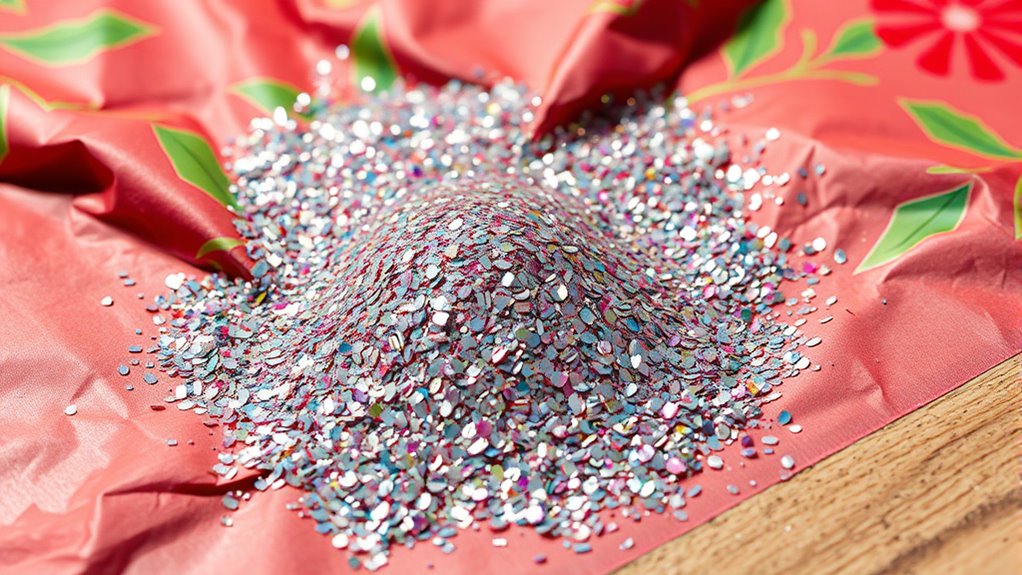When you use glitter in gift wrap, you’re contributing to microplastic pollution that harms marine ecosystems and is tough to clean up. Traditional plastic glitter takes over 100 years to decompose and can end up in oceans, where aquatic animals ingest tiny particles, disrupting food chains. Eco-friendly alternatives exist, but many are overlooked. By understanding the impact, you’ll see how your choices can make a difference and discover ways to reduce your glitter footprint.
Key Takeaways
- Glitter in gift wrap often contains microplastics that persist in the environment for over 100 years, contributing to long-term pollution.
- Microplastic particles from glitter are ingested by marine wildlife, disrupting ecosystems and entering the human food chain.
- Recycling is hindered by glitter contamination, making waste management and recycling efforts less effective and increasing environmental burden.
- Eco-friendly alternatives like biodegradable and mineral-based glitter decompose faster, reducing pollution and marine ecosystem harm.
- Consumer choices and policy support are crucial to promoting sustainable gift wrapping materials and minimizing glitter’s environmental impact.
What Is Glitter Made Of and How Is It Used in Gift Wrap?
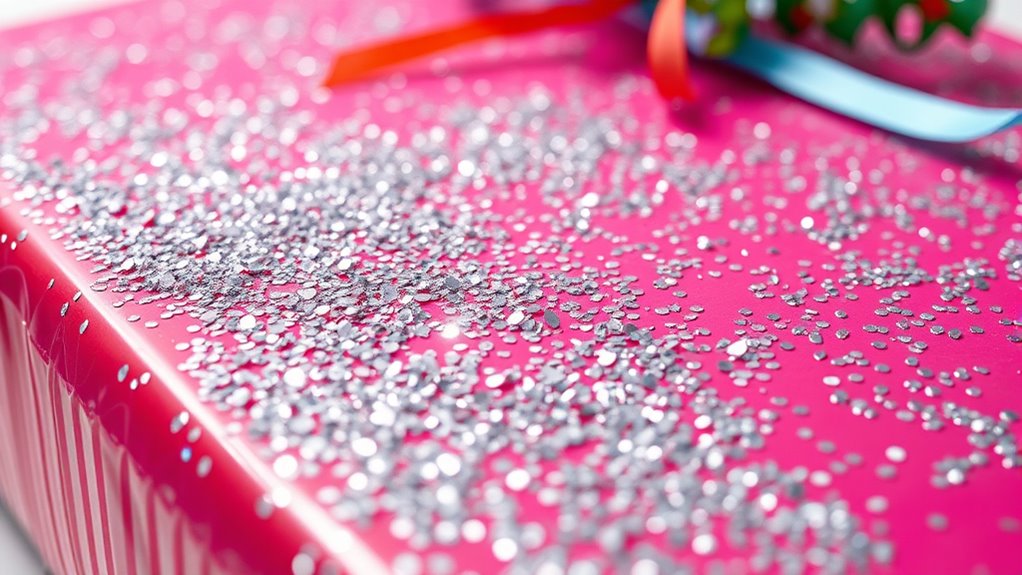
Glitter is made from tiny, reflective particles that add sparkle and shine to gift wrap. Its composition typically includes plastic, such as polyethylene terephthalate (PET), combined with colorants and sometimes a binder to hold the particles together. This creates a shiny, eye-catching effect that makes your gift wrap stand out. You’ll often see glitter used as a decorative element in gift wrap decoration, enhancing the visual appeal with its sparkling surface. Many types of glitter are designed to be lightweight and easy to sprinkle or glue onto wrapping paper. While it looks beautiful, knowing what glitter is made of helps you understand its durability and how it’s applied in gift wrap decoration, making your presentation more festive and attractive. Additionally, concerns about environmental impact highlight the importance of understanding the composition of glitter and its effects on ecosystems.
The Microplastic Problem: How Glitter Contributes to Marine Pollution
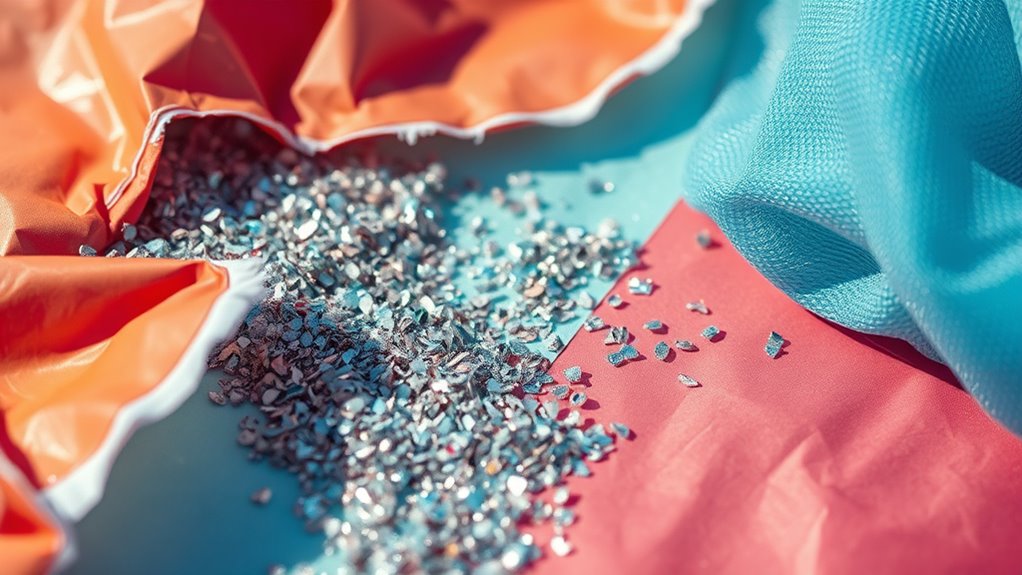
When glitter washes into the ocean, tiny plastic particles scatter through marine environments, harming sea life. These microplastics can be ingested by fish and other creatures, disrupting ecosystems. Cleaning up this pollution is tough because these particles are so small and spread widely, making it a persistent problem. Incorporating sustainable materials into manufacturing processes can help reduce the amount of plastic waste entering our oceans. Additionally, developing energy-efficient production methods can lessen the overall environmental footprint of glitter manufacturing. Implementing biodegradable alternatives can further minimize long-term pollution and help protect marine biodiversity.
Tiny Plastic Particles
Tiny plastic particles from glitter are a significant contributor to marine pollution, as they easily escape into water systems during production, use, and disposal. These microplastics, often made from non-biodegradable materials, persist in the environment long after they’re discarded. To reduce this impact, consider these options:
- Switch to biodegradable glitter, which breaks down naturally and minimizes pollution.
- Choose gift wrap with eco-conscious packaging that discourages the use of microplastic-containing products.
- Reduce glitter use altogether or opt for natural alternatives like shimmer from crushed minerals.
- Support brands committed to eco-friendly practices that limit tiny plastic particles in their products.
Marine Ecosystem Damage
Because microplastics from glitter often escape into water systems, they pose a serious threat to marine ecosystems. Tiny glitter particles can be ingested by marine life, harming fish, seabirds, and other creatures. These microplastics accumulate in the food chain, affecting species at all levels. To reduce this damage, switching to biodegradable options can make a difference, as these materials break down more quickly and don’t persist in the environment. Choosing eco conscious packaging that minimizes plastic use also helps prevent glitter from polluting oceans and waterways. Incorporating vibrational alignment techniques to foster a mindset of environmental responsibility can further motivate sustainable choices. Additionally, awareness of AI’s impact on privacy and regulation can lead to more informed decisions about the materials we choose, ensuring that innovations support environmental sustainability. Educating consumers about the microplastic problem and its effects can encourage more responsible purchasing habits. By making mindful choices, you can help protect marine ecosystems from microplastic contamination, ensuring cleaner waters and healthier marine life for future generations. Small changes in packaging habits can profoundly reduce glitter’s impact on our oceans.
Difficult Cleanup Processes
Removing glitter from water systems proves to be an incredibly challenging task due to its small size and persistent nature. Glitter composition, primarily microplastics, makes cleanup efforts difficult because it easily slips through filters and sinks into ecosystems. You face several cleanup challenges:
- Tiny particles evade standard filtration methods.
- Microplastics cling to marine organisms, spreading pollution.
- Traditional cleanup tools are ineffective against such small debris.
- Once dispersed, glitter remains in water for years, continually contributing to pollution.
- The filtration systems in place often lack the capacity to capture microplastic particles effectively. Additionally, the cost and resource requirements for advanced filtration technologies can be prohibitive, limiting widespread implementation. The persistence of microplastics in aquatic environments ensures that even small amounts of glitter can cause long-term damage.
These factors make it nearly impossible to fully remove glitter once it enters water systems. Its microplastic composition ensures it persists, complicating cleanup processes and increasing environmental harm. Addressing these challenges requires innovative solutions and stricter regulations to prevent further pollution.
Environmental Consequences of Glitter Waste in Landfills and Waterways
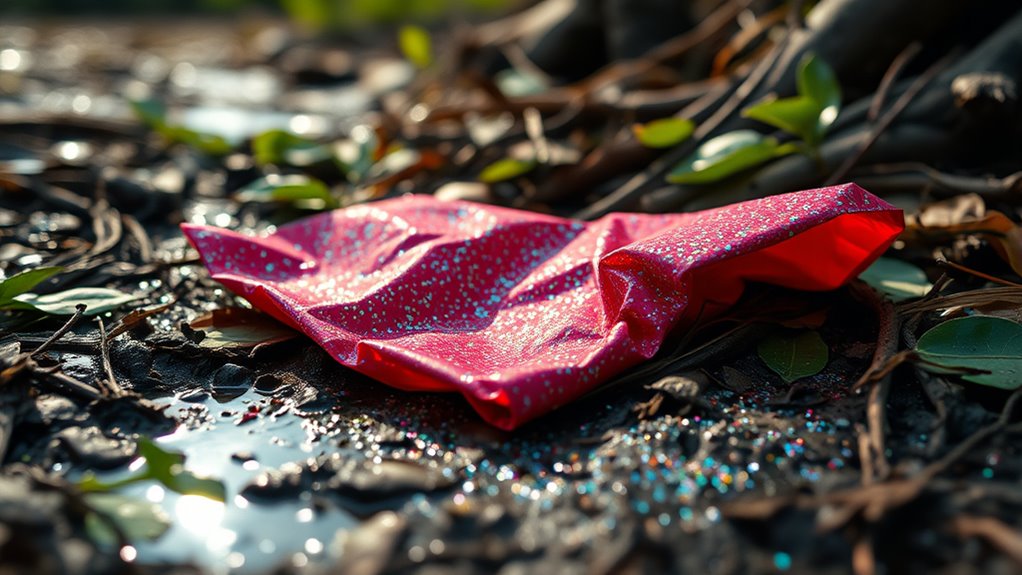
When glitter ends up in landfills or waterways, it doesn’t just sit quietly; it breaks down into tiny particles that persist for years. These microplastics pollute water systems and fill up landfills, creating long-term waste problems. As a result, ecosystems face risks of contamination and damage that can affect wildlife and human health.
Microplastic Pollution in Water
Glitter particles from gift wrap often escape into waterways during disposal or cleanup, contributing considerably to microplastic pollution. Once in the water, tiny particles are ingested by marine life, disrupting ecosystems and entering the food chain. To reduce this impact, you can:
- Choose biodegradable options that break down naturally and don’t persist in water.
- Support companies offering glitter alternatives made from plant-based or mineral materials.
- Use eco-friendly cleaning methods to prevent glitter from washing into drains.
- Educate others about the importance of responsible disposal and choosing sustainable wrapping options.
- Understanding contrast ratio and its role in projectors can inspire eco-friendly presentation techniques that minimize resource use. Additionally, selecting eco-conscious materials for wrapping can significantly lessen environmental harm. Incorporating sustainable packaging practices further reduces waste and supports environmental conservation efforts.
Landfill Accumulation Issues
Although glitter adds sparkle to gifts, it often ends up in landfills where it accumulates over time, posing significant environmental risks. Non-biodegradable glitter persists for years, leaching chemicals and contributing to microplastic pollution. Your choice of biodegradable alternatives can reduce this impact, but many consumers remain unaware of glitter’s long-term effects. Landfill buildup worsens as glitter fragments break down slowly, contaminating soil and water. To understand this better, consider the table below:
| Glitter Type | Decomposition Time | Environmental Impact |
|---|---|---|
| Traditional Plastic | 100+ years | Microplastic pollution |
| Biodegradable | 6 months – 2 years | Less toxic, eco-friendly |
| Mineral-based | 2-5 years | Minimal impact |
| Recycled Options | Varies | Reduces waste and toxicity |
In addition, public awareness campaigns about biodegradable options can play a vital role in curbing landfill accumulation issues. Increasing consumer education on eco-friendly glitter alternatives can further encourage responsible disposal practices.
Raising consumer awareness about biodegradable options helps curb landfill accumulation issues. Additionally, promoting home decor choices that incorporate eco-friendly materials can further lessen environmental harm.
Ecosystem Damage Risks
As glitter accumulates in landfills and waterways, it poses serious threats to ecosystems. Tiny plastic particles can be ingested by aquatic animals, disrupting food chains. Here are four key risks:
- Ingestion by wildlife, leading to injury or death.
- Contamination of water sources, harming aquatic plants and animals.
- Persistent pollution, as traditional glitter doesn’t biodegrade. Predictive analytics can help identify areas most at risk of such pollution, enabling targeted cleanup efforts.
- Impact of microplastics, which can enter human food supplies. Switching to biodegradable glitter reduces these risks, as it breaks down naturally. Additionally, choosing natural fiber wrapping for gifts minimizes plastic waste. Moreover, understanding the industry transformations surrounding eco-friendly alternatives can guide consumers toward better choices. Recognizing the importance of beach conservation efforts helps in reducing overall environmental impact. By understanding these risks, you can make more eco-friendly choices that protect ecosystems from glitter’s harmful effects.
The Challenges of Recycling Glitter-Decorated Packaging

Recycling glitter-decorated packaging presents significant hurdles because the tiny particles are difficult to separate from paper or plastic materials. These microglitter particles tend to cling tightly, causing contamination during recycling processes. This contamination complicates waste processing and often leads to packaging being discarded rather than recycled. While biodegradable options exist, they don’t always solve these recycling challenges, as microplastics from traditional glitter still pollute waterways and ecosystems. The small size of glitter makes it nearly impossible for standard sorting machines to remove, increasing the risk of microplastic leakage. As a result, many recycling facilities struggle to handle glitter-covered packaging efficiently. To address these issues, innovative solutions and better sorting technologies are needed, but current practices still fall short in managing glitter effectively during recycling. Additionally, necessary cookies play a role in monitoring and improving recycling processes to reduce environmental impact. Improving recycling technology could significantly mitigate these challenges and promote more sustainable packaging options. Enhanced sorting methods are essential to prevent microplastic pollution and improve recycling rates for glittered materials.
Eco-Friendly Alternatives to Traditional Glitter in Gift Wrapping
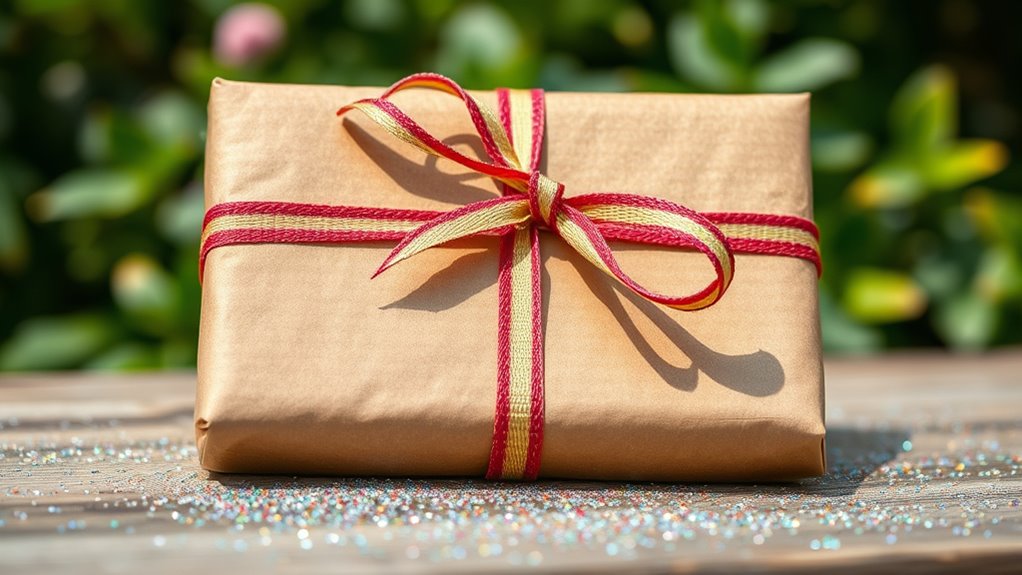
To reduce environmental harm, many gift wrap manufacturers are turning to eco-friendly alternatives to traditional glitter. These biodegradable options help minimize plastic waste and support corporate responsibility. Here are four popular choices:
- Biodegradable cellulose glitter made from plant fibers, which decomposes naturally. Biodegradable materials ensure that the glitter does not persist in the environment after disposal. Additionally, adopting these materials aligns with sustainable manufacturing practices that are increasingly encouraged globally.
- Mineral-based glitter composed of mica or other eco-friendly minerals, offering sparkle without plastic.
- Water-based or vegetable-based glitter that dissolves easily in water, reducing pollution.
- Recyclable paper embellishments with eco-friendly shimmer coatings, promoting sustainable packaging.
Additionally, understanding the impact of Legislative changes can guide manufacturers in adopting environmentally friendly materials more effectively.
How Consumers Can Reduce Their Glitter Footprint During Gift Giving
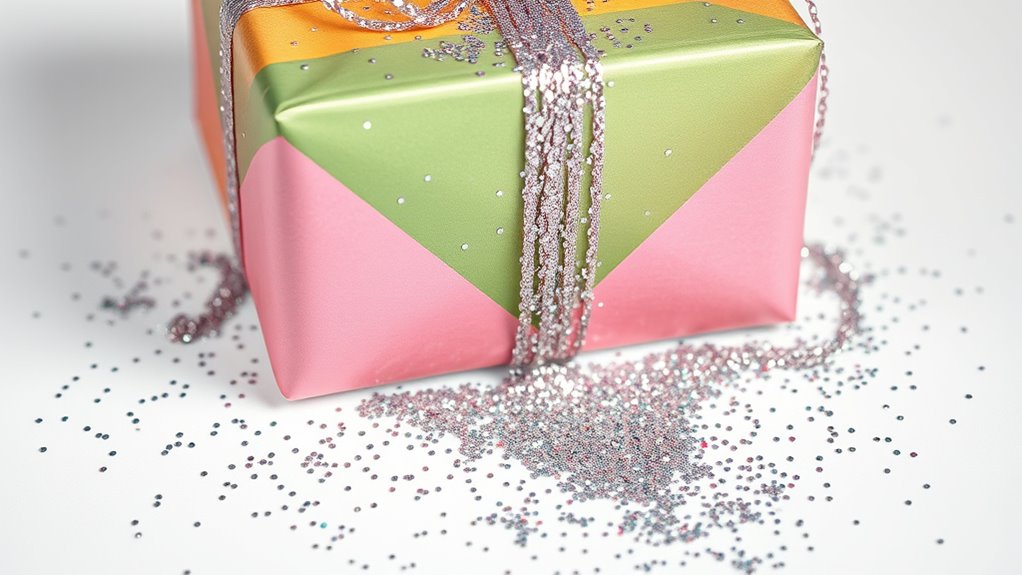
Choosing eco-friendly glitter alternatives for gift wrapping is a great start, but consumers also play an essential role in reducing their overall glitter footprint. You can opt for biodegradable glitter, which breaks down naturally and minimizes environmental harm. When wrapping your gifts, consider using reusable gift wrap, such as fabric or decorative boxes, instead of single-use paper with glitter. This reduces waste and prevents glitter from shedding into the environment. Be mindful of how you decorate your presents—choose minimalist designs or natural accents that don’t rely on glitter. Additionally, you can remove glittery embellishments before recycling or discarding wrapping materials. Small changes, like selecting biodegradable options and embracing reusable wrap, considerably lessen your contribution to glitter pollution during gift giving.
The Role of Manufacturers and Policy Changes in Promoting Sustainable Gift Wrap Options
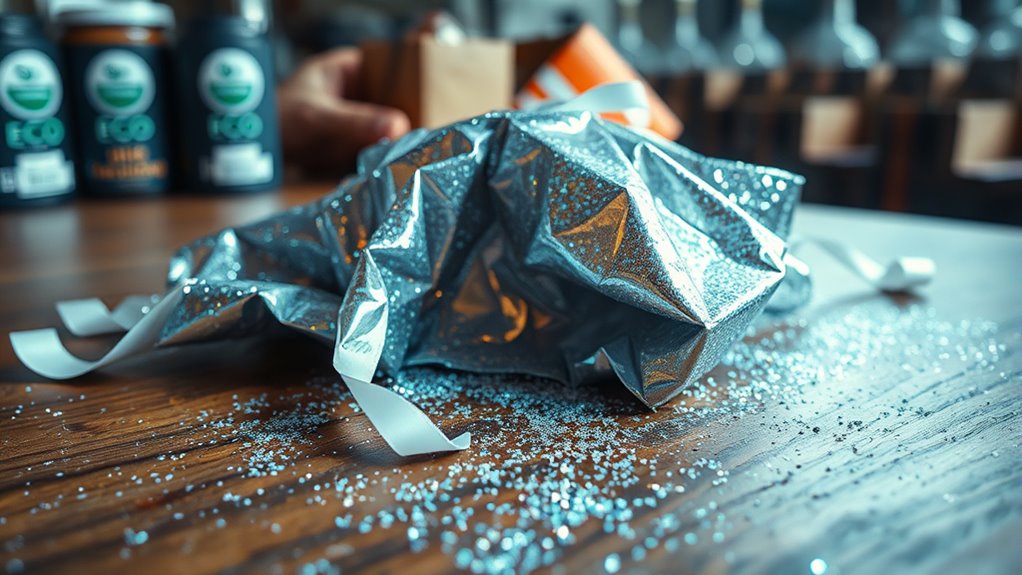
Manufacturers and policymakers have a crucial role in advancing sustainable gift wrap options by encouraging the development and adoption of eco-friendly materials. Through sustainable manufacturing practices, they can reduce environmental impact and create greener alternatives. Policy advocacy also plays a vital role in this shift. Here’s how:
- Implementing regulations that favor biodegradable and recyclable materials.
- Providing incentives for brands that produce eco-friendly gift wraps.
- Supporting research into innovative, sustainable materials.
- Promoting standards that limit harmful substances in packaging.
Frequently Asked Questions
Can Glitter Be Safely Disposed of Without Harming the Environment?
You can dispose of glitter safely by choosing biodegradable alternatives and eco-friendly disposal methods. Regular glitter often contains microplastics that harm the environment, but biodegradable options break down naturally without polluting waterways or soil. To be eco-conscious, avoid flushing glitter and instead compost or dispose of it in designated waste bins. Using biodegradable glitter guarantees you celebrate sustainably while protecting the environment from microplastic pollution.
Are There Certifications Indicating Eco-Friendly Glitter Products?
You’re wondering if eco label programs and sustainable certifications can help identify eco-friendly glitter products. These certifications, like FSC, EcoCert, or Green Seal, signal that the glitter meets strict environmental standards. By choosing products with these labels, you guarantee they’re made sustainably and are less harmful to the environment. Always look for reputable eco label programs to make informed and eco-conscious choices when purchasing glitter.
How Long Does Glitter Typically Take to Decompose in Nature?
They say “good things take time,” but glitter’s biodegradation timeline defies that truth. You might expect it to disappear quickly, but in reality, it can persist for hundreds of years due to its environmental persistence. Glitter made from plastic often takes centuries to fully decompose in nature, leaving a lasting mark on ecosystems. So, if you’re concerned about environmental impact, consider eco-friendly alternatives that break down much faster.
What Are the Health Risks Associated With Microplastic Glitter Exposure?
You should be aware that microplastic glitter poses health risks if ingested or if it contacts your skin. Microplastic ingestion can cause digestive issues and potential toxin absorption, while skin irritation might result from tiny particles. When handling glitter, especially during craft activities or gift wrapping, you could inadvertently expose yourself to these risks. To stay safe, minimize direct contact and wash your hands thoroughly afterward.
Are There Government Regulations Governing Glitter Use in Packaging?
You might wonder if there are federal restrictions or industry standards governing glitter use in packaging. Currently, regulations are limited, but some governments are starting to implement rules to reduce microplastic pollution. Industry standards vary, with some companies adopting eco-friendly alternatives voluntarily. While federal restrictions aren’t widespread yet, expect increasing oversight as environmental concerns grow. Staying informed helps you choose packaging that aligns with evolving regulations and standards.
Conclusion
So, as you wrap your next gift, think about the hidden impact of glitter. Will you choose eco-friendly alternatives or stick with traditional sparkle? The choices you make now could shape the future of our planet’s waterways and landfills. The question isn’t just about decoration — it’s about whether you’ll let glitter’s true cost go unnoticed or take a stand for a more sustainable celebration. The power is in your hands.
